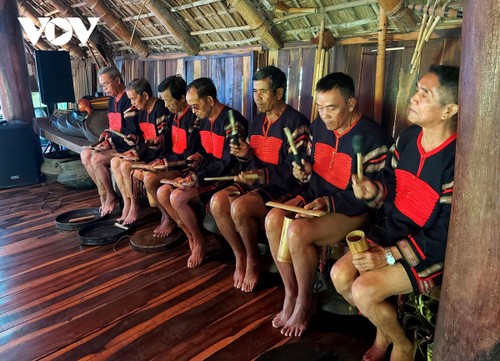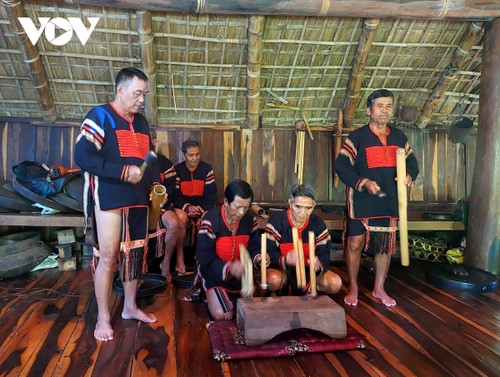 Gong players of Ako Sier hamlet, Buon Ma Thuot city. Gong players of Ako Sier hamlet, Buon Ma Thuot city. |
The gong players of Ako Sier hamlet in Buon Ma Thuot city often play a Plier theme. Plier means “hail”. The gong’s strong, quick rhythm mimics the sound of striking hailstones.
The Plier theme is played during a wine invitation ceremony. Emeritus Artist Vu Lan says Ede gong players have made changes to the Plier theme.
“In the Plier theme, they include calls at the beginning of the performance. The changes emphasize the suddenness of hail in the Central Highlands. They also combine folk melodies in other gong performances,” Lan said.
Artisan Y Due Niê Kdam of Ako Sier hamlet was the first to remix the Plier theme. He said gong performances often accompany worship rituals and animal sacrifices. After the ritual, people queue in a line for a wine invitation ceremony. They drink vases of wine to the rapid-fire sound of gongs for many hours.
 Artists manage to integrate musical instruments in traditional gong performances. Artists manage to integrate musical instruments in traditional gong performances. |
“During the New Year Festival, we worship, perform animal sacrifice rituals, play gongs, and drink wine together. We play gongs for hours and don’t repeat the melodies. At first we play impromptu melodies and then remix them with traditional themes,” said Nie Kdam.
The gong troupe of Ako Sier hamlet is famous in Buon Ma Thuot city. They often represent Dak Lak province at festivals and cultural exchanges. Artisan Y Mip Ayun says the modern changes make their performances more accessible, not only during ceremonies but as entertainment.
“We try to preserve traditions while renewing them. Performances of gongs or any other musical instrument should be creative and continue to evolve,” said Y Mip Ayun.
Folklorist Vu Lan said cultural values are an inheritance that must develop to keep pace with changing life. Cultural preservation should also be responsible to community needs.
“The new variations are fantastically different from the original version. We appreciate their creativity. To create folk art is not the work of one person, but of the whole team and the community. Gong performances have adapted to contemporary life,” Lan said.